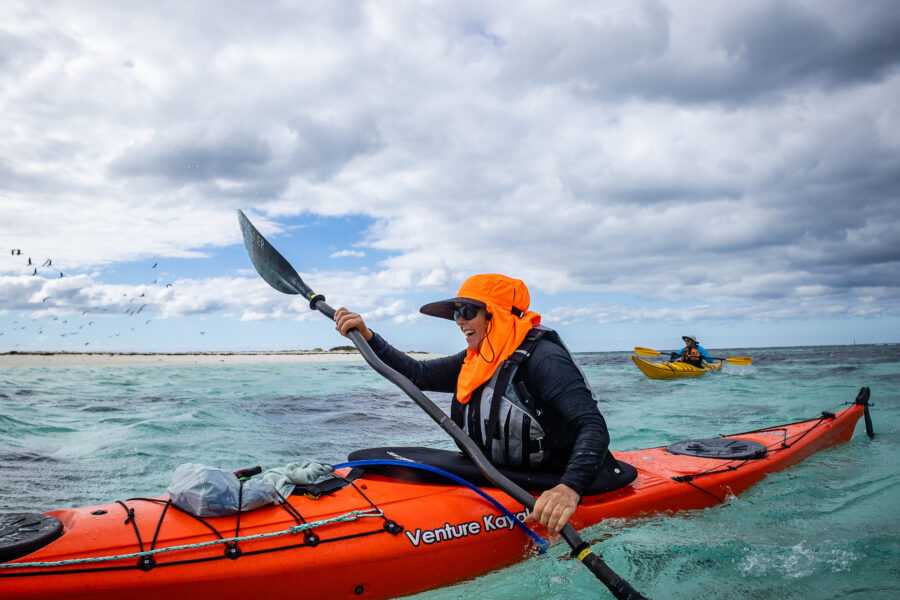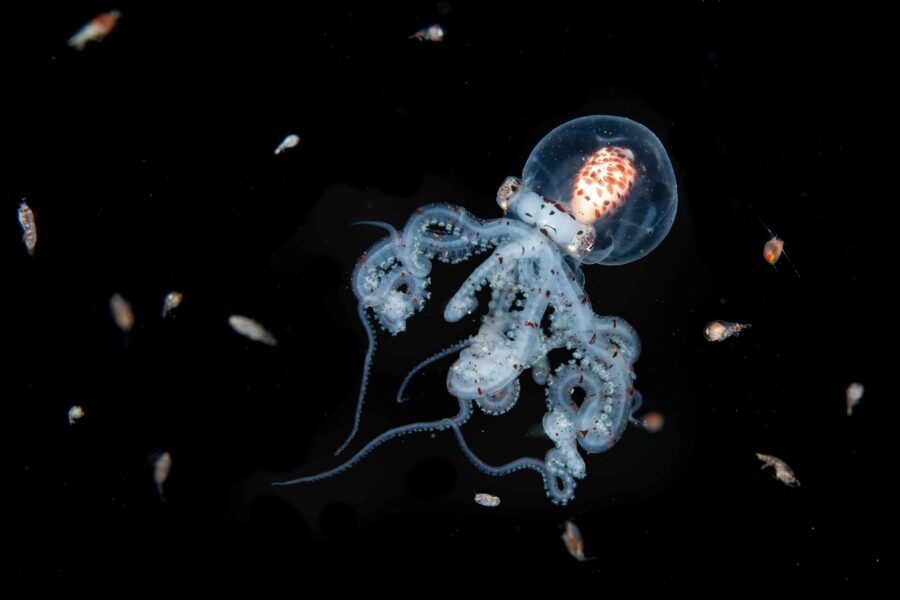Purnululu: A fragile icon
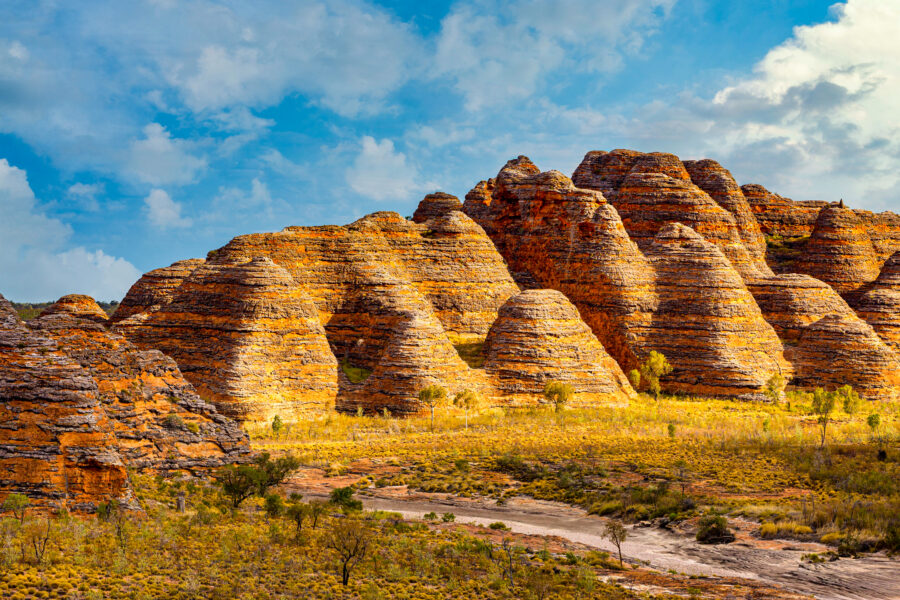
Deep in the East Kimberley it lay in wait: its dazzling colours and sculpted landforms known only to a few.
It wasn’t until 1983 that airborne treasure-seekers, in the form of a documentary crew, dug up the booty; their film Wonders of WA unearthing the spectacular striped jewellery we know as the Bungle Bungles. Within weeks, ground crews set out in 4WDs to steal a look at the loot.
In 1987, this glittering treasure was declared a national park, and it was inscribed on the World Heritage register just four years ago.
The treasure-seekers still come today – in planes, helicopters and 4WDs – to open the chest and gaze at the fragile wonders within.
Colours of Purnululu
It’s the colours that blew me away. They’re almost gaudy: towering, striped orange and black rocks, golden splashes of flowering wattles, spinifex greener than the lushest lawns, cloudless blue skies, and the whole lot lavishly reflected in inviting pools.
Most of the 43,000 people who visit Purnululu National Park each year come to see the beehive-like bungles. These fragile formations (a landform found in just a few spots in the world) were created as water eroded the Bungle Bungle Range over the past 20 million years – a relative twinkle in the earth’s geological eye.
From the air or from a distance, some look like little pyramids or the turrets of ancient castles. Their unusual banding is only skin-deep. It’s dark grey or black in layers where clay particles hold remnants of the wet season’s deluge for long enough to encourage cyanobacteria to live, and it’s orange where iron oxide has leached to the surface. The slightest touch breaks this thin skin, and the white sandstone underneath blows away in the wind like the finest flour, for it has no silica or other bonding material.
When the sun is low on the horizon, these formations, which locals casually refer to as “The Bungles”, morph through an explosion of colours – purples, crimsons, reds and oranges. During the day, shifting shadows accentuate their shapes and structure, and the sun bleaches the colour from the rock, just as water over time has leached the iron oxide from within.
“It’s pretty hard to leave here without saying ‘Wow’,” says Paul Wainwright, who’s lived and worked in the Bungles for 24 years. “I still go down to the beehive formations and just never get sick of it. There’s always something a little bit different. Colours change. This year we had this big, late Wet and everything’s very green.”

Now the manager of East Kimberley Tours (EKT), Paul was one of the first 4WDers who came in June 1983 and became the co-discoverer of two of the park’s main attractions, Echidna Chasm and Mini Palms Gorge.
A slot in the range just a couple of metres wide, Echidna puts on a spectacular display in the middle of the day when the sun penetrates its dark recesses. Paul and his dad found the way in while exploring the steep-sided north-western face of the Bungle Bungle Range. “We got into where it bells out a bit, and we thought that was where it ended… but it keeps going,” he says. “Still today, Echidna is one of my favourite spots.”
Stunning Livistona palms guard Echidna’s entrance, their long green fronds giving high fives to each other while rainbow bee-eaters zip about and great bowerbirds dine on wild passionfruit. The conglomerate rock here is chunky, with large rocks and boulders compressed into 180m high orange walls. Palms lean precariously over the top of these, seemingly craning their long necks to listen to the echoing voices and occasional yodelling that rise from the skinny chasm.
The palms predominate among the vines, figs and other vegetation at nearby Mini Palms Gorge, its walls – although much further apart – still providing deliciously cool respite from temperatures that push 30°C even in the coolest months.
From the air, it becomes clear these gorges are just two of the many sliced into the 45,000 ha range that withholds secrets of hidden caves, ancient peoples and unknown plants. Some, such as Echidna, are so deep and narrow they only see the sun for a fraction of the day. Trees stand shoulder to shoulder in the gorges, but the plains and ridges are more like a dot painting, with space between the bloodwoods and range gums.
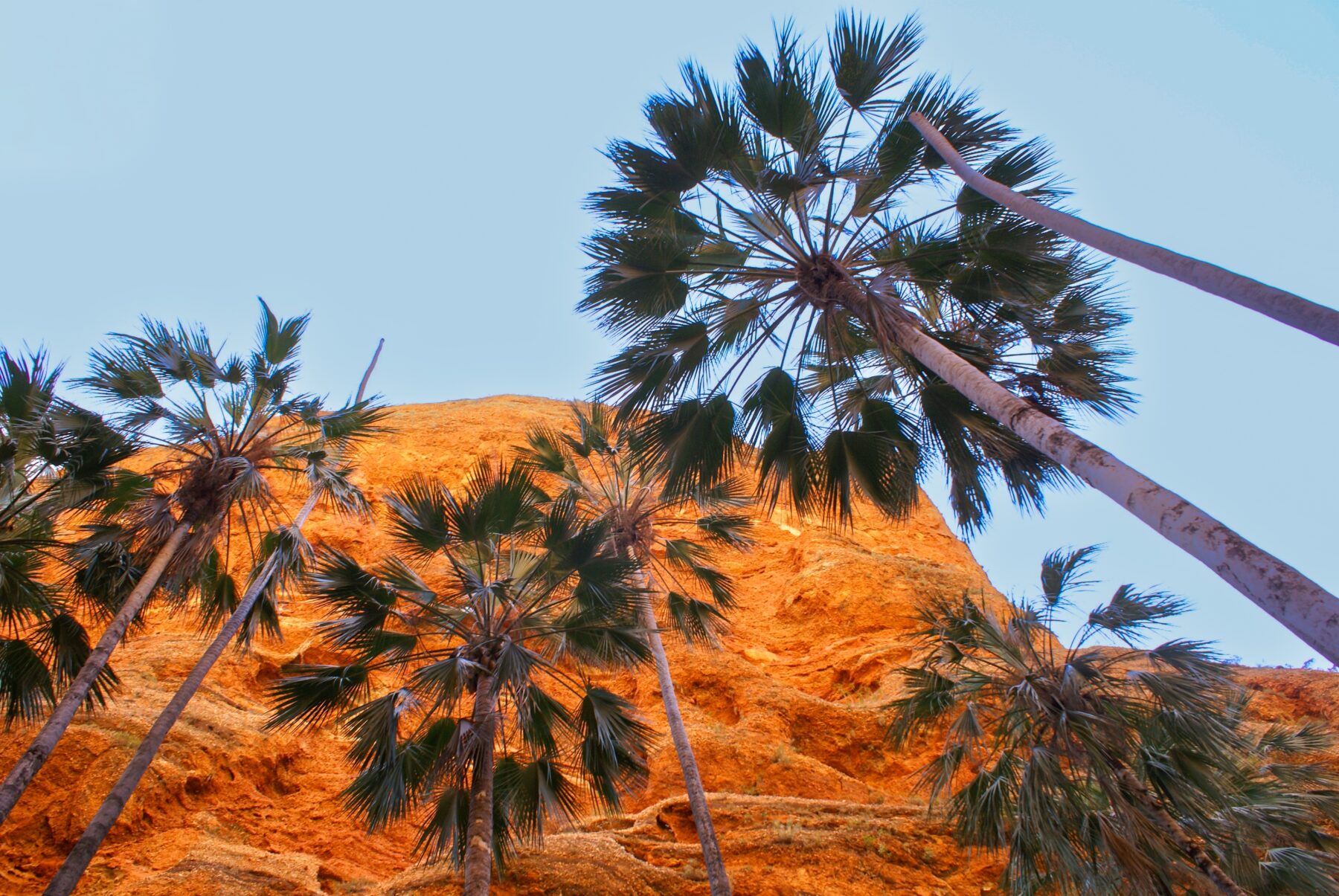
Close to the airstrip on the south-west of the range sit two luxurious camps, run by EKT and Australian Pacific Touring (APT) Kimberley Wilderness Adventures. Each is licensed to take up to 60 guests, their semi-permanent tents (some with showers and flushing dunnies) set among wattles, bauhinia trees and native hibiscus.
Lazy birdwatchers need go no further – beautiful red-backed fairy-wrens flit around camp, double-barred finches fly in for a drink, pheasant coucals noisily squabble and hundreds of other birds join the recital at dawn.
It’s a 20-minute drive from here to the heart of the Bungles formations, and the starting point for the walks into Cathedral and Piccaninny gorges. The dusty 4WD track winds through stands of Wickhams grevillea, their drooping red blooms a vibrant contrast to the dazzling wattles. Peaceful doves scurry out of the way into the spinifex, beside bachelor’s buttons and tall mulla-mulla.
Almost disconcerting in such a beautiful place, the car park at the end of the track is busy, with people milling around and noisy air-conditioning units running in 4WD buses. But maybe that’s just added incentive to strap on a full backpack and head up the park’s premier walk, Piccaninny Gorge.
Piccaninny dreaming
You won’t be the first to travel the upper reaches of Piccaninny, but at times, you’ll feel as though you are.
After crunching over river rocks and slogging through thick sand for the best part of a day, you’ll reach the area where the outstretched tributaries, called “The Fingers”, stretch towards the plateau on top of the range. Military dragons scuttle across the rocks, and long-tailed Mertens monitors wiggle like sea snakes through rock pools populated by small fish. The pools in full sun are tepid, but those in the shade are refreshingly cool.
I explored this remote paradise with AG Society-sponsored researcher Thalie Partridge, who was only too keen to jump into waterholes along the way in the bush girl’s classic bikini – bra and undies. “I love this climate,” she laughed, knowing her Blue Mountains home near Sydney would by now have an autumn chill.
In some places, where the towering orange walls pressed in, we swam through deep waterholes with packs on our heads. In other areas the gorge opened out – maybe 200m across – and white-trunked brittle range gums poked up through the rocks and spinifex.
The air was thick with the honeyed aroma of spinifex resin – Purnululu has 13 species, the highest diversity in Australia, because it’s where the desert plants meet their northern cousins. Some of the spinifex species are soft, just gently brushing the calves of passers-by. But others are the needle-sharp, hard varieties that stab and pierce, injecting stinging resin. I guess it’s one way that the gorge discourages too many explorers.

But it doesn’t stop Marian Lester. We found her walking barefoot through the spinifex, her party of female friends relaxing and skinny-dipping at the start of The Fingers. Marian has been bringing people up the gorge – as a guide and for fun – since 1991. “It still takes my breath away every time I come here,” she says. “Different seasons, different light.”
Marian’s group were camping up the gorge for 10 days. “I wouldn’t bring in people for anything less than five nights – you’ve done all the hard work to get in here, so you may as well enjoy it.”
Enjoy it we did: following creek lines, climbing over boulders and through tunnels, admiring beautifully carved round waterholes alive with frisky 2cm rockhole frogs. It reminded me of canyoning, back near Thalie’s home in the Blue Mountains. Spectacular fire-engine-red dragonflies – and blue ones too – zipped around the waterholes and white-quilled rock-pigeons fluttered with a noisy clack-clack. In one long-grassed side gully I startled a yellow-bellied whip snake. Or maybe it startled me.
Towards the end of the day, we plunged into a cool waterhole beside a resting nankeen night heron, soaking our spinifex cuts and cooling down feet. A butcherbird or some other sweet singer sent its whistling call down the gorge – wind-chime lullabies. We slept on the deep, soft river sand beside a waterhole where microbats whizzed around catching insects.
In the morning, crow calls echoed down the gorge like old men laughing.
Aerial sightseeing of Purnululu
The first plane of the day flew over at 6.50am. Nine helicopters and eight planes would follow it that day, keeping a semi-constant hum in the gorge. Of the 43,000 people who visit the park each year, nearly half see Purnululu only by air. They fly in from Kununurra, do a scenic circuit – all on the same prescribed route – and buzz off again.
According to Purnululu’s long-term ranger, Lindsay Brown – who spoke to me while he scoffed down some dinner before rushing off to organise a Royal Flying Doctor Service evacuation for someone who had food poisoning – the aerial sightseers are good environmental news for the park. “We get as many people flying over the place as touch the ground,” he says. “But they have lower impact. We haven’t got the facilities to deal with that many people on the ground.”
There’s been talk – but no action yet – of sealing the rough track in, which would open up the park to coach tours and 2WD travellers. Most long-term Purnululu lovers – even, surprisingly, most of the commercial operators – hope this never happens. “That would kill it,” says Phil Cox, APT’s regional manager. “We’ve got an iconic attraction there that just blows people away when they see it, and we’ve gotta learn from the mistakes we’ve made in other places.”
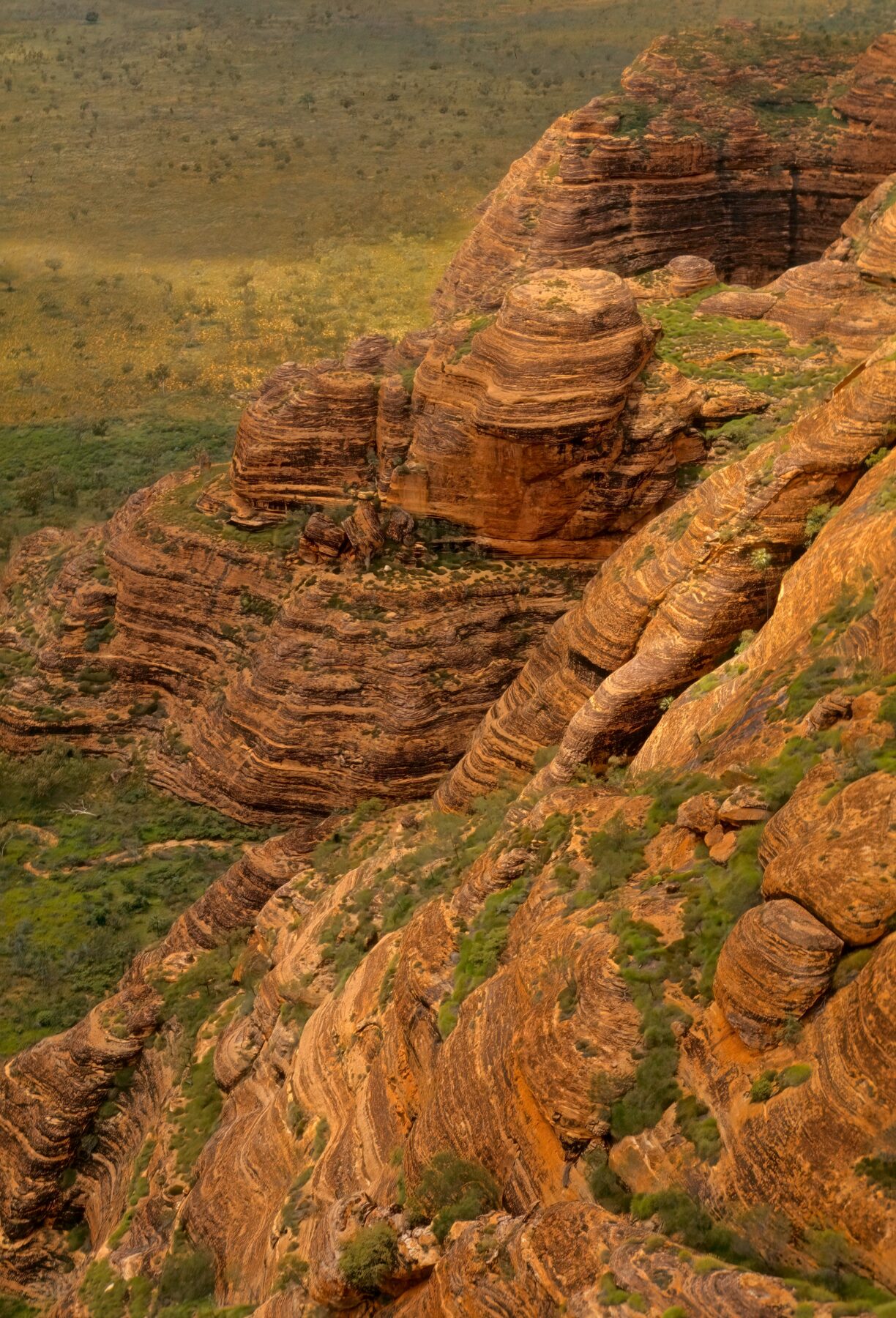
The two public camping grounds take about 300 people between them, and apart from the APT and EKT camps, they’re the only places to stay. “The park could take 40,000 a year on the ground,” Lindsay says, “but not in the June–August period when most people come. We need to stretch it out from April to October.” He says that the park management is considering a booking system to control numbers during the busy months.
Another plan to spread the visitors out is to open up more areas of the park – options are currently being discussed with traditional owners who jointly manage the park with the WA Department of Environment and Conservation. “You don’t wanna be in Echidna with 300 people. You don’t wanna be in Cathedral with 300 people,” Lindsay says. “But the WA public fund this park and they have every right to be here.”
Purnululu artist Nadeen Lovell, who is on the Kununurra Visitor Centre’s Board of Management, and was the first female 4WD guide in Purnululu from 1991, agrees that more areas of the park should be accessible. “It’s a huge place, and we’re going to very little of it,” she says. “Four gorges for all those thousands of people – in actual fact, they’ve closed the end of Mini Palms and Froghole, so there are fewer areas than before.”
Lindsay says that because of the fragility of the Purnululu landscape, the human footprint is the biggest management issue. “The highest priority is protection of the very thing that people have come here to see,” he says. “If you don’t surface-harden everything it’ll wear away in the wet season – car parks, campgrounds, roads, tracks.” Last year, work crews installed ladders and cemented rock walls in Echidna Chasm, and built stairways on the track to Cathedral Gorge. And although it’s usually done subtly, the work reminds us that in merely travelling to these beautiful places, we have an impact upon them. Just walking on Purnululu’s fragile rock can wear tracks in it.
Twenty years ago, about 2,000 people visited the park each year. This has steadily risen, and the much-deserved World Heritage listing in 2003 appears to have attracted even more travellers. On my last afternoon in Purnululu, I contemplated this as I picked my way through spiky spinifex and a natural orchard of low-growing bush tomatoes. The Bungle Bungle massif in the east glowed in the late afternoon sun, and a smattering of termite mounds, 2m or so in height, echoed the shapes of the Bungles on the other side of the range.
Lines of dust in the green and rust-brown landscape showed more tourists arriving on the track, keen for their own glimpse into the Bungles’ rich treasure chest.

